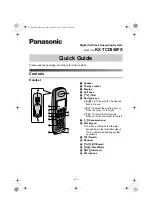
23
Working Advice
The width of cut varies depending on the saw blade used.
Protect saw blades against impact and shock.
Guide the machine evenly and with light feed in the cutting
direction. Excessive feed significantly reduces the service life
of the saw blade and can cause damage to the power tool.
Sawing performance and cutting quality depend essentially
on the condition and the tooth form of the saw blade. There-
fore, use only sharp saw blades that are suited for the material
to be worked.
Sawing Wood
The correct selection of the saw blade depends on the type
and quality of the wood and whether lengthway or crossway
cuts are required.
When cutting spruce lengthways, long spiral chips are
formed.
Beech and oak dusts are especially detrimental to health.
Therefore, work only with dust extraction.
Sawing with Parallel Guide
(see figure D)
The parallel guide
12
enables exact cuts along a workpiece
edge and cutting strips of the same dimension.
Sawing with Auxiliary Guide
(see figure E)
For sawing large workpieces or straight edges, a board or
strip can be clamped to the workpiece as an auxiliary guide;
the base plate of the circular saw can be guided alongside
the auxiliary guide.
Sawing with Guide Rail (see figure G)
The guide rail
34
is used to carry out straight cuts.
Note:
Use the guide rail
34
only for right-angled cuts. When
using for mitre cuts, the guide rail
34
can become damaged.
The adhesive coating prevents the guide rail from slipping
and protects the surface of the workpiece. The coating of the
guide rail allows the circular saw to glide easily.
Place the circular saw directly onto the guide rail
34
. Fasten
the guide rail
34
with suitable clamping devices, e. g., screw
clamps, on the workpiece in such a manner that the narrow
leg of the guide rail
34
faces toward the saw blade.
The guide rail 34 must not extend beyond the face
side of the workpiece where the cut is to be
started.
Switch the machine on and guide it in the cutting direction
applying moderate and steady feed.
Two guide rails can be connected using the connection piece
36
. Clamping is carried out with the four screws located in the
connection piece.
Recommendations for Optimal Han-
dling of the Battery
Protect the battery against moisture and water.
Store the battery only within a temperature range between
–20 °C and 50 °C. As an example, do not leave the bat-
tery in the car in summer.
Occasionally clean the venting slots of the battery using a
soft, clean and dry brush.
A significantly reduced working period after charging indi-
cates that the battery is used and must be replaced.
Observe the notes for disposal.
Maintenance and Cleaning
Before any work on the machine itself (e. g.
maintenance, tool change, etc.) as well as dur-
ing transport and storage, remove the battery
from the power tool.
There is danger of injury when
unintentionally actuating the On/Off switch.
For safe and proper working, always keep the
machine and ventilation slots clean.
The retracting blade guard must always be able to move
freely and retract automatically. Therefore, always keep the
area around the retracting blade guard clean. Remove dust
and chips by blowing out with compressed air or with a brush.
Saw blades that are not coated can be protected against cor-
rosion with a thin coat of acid-free oil. Before use, the oil must
be removed again, otherwise the wood will become soiled.
Resin and glue residue on the saw blade produces poor cuts.
Therefore, clean the saw blade immediately after use.
If the machine should fail despite the care taken in manufac-
turing and testing procedures, repair should be carried out by
a Würth master-Service.
In all correspondence and spare parts orders, please always
include the article number given on the type plate of the
machine.
The current spare parts list for this power tool can be viewed
on the internet at http://www.wuerth.com/partsmanager or
be requested from your next Würth branch office.
OBJ_BUCH-3291-001.book Page 23 Friday, September 8, 2017 12:22 PM













































